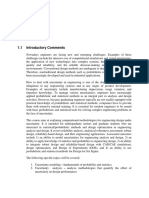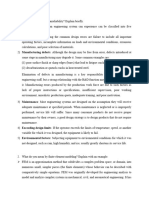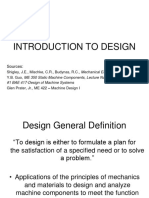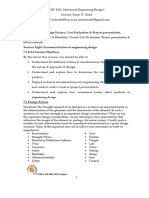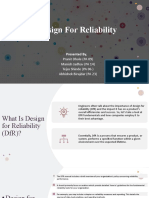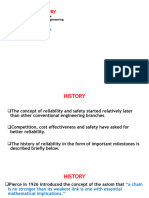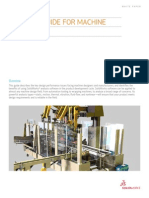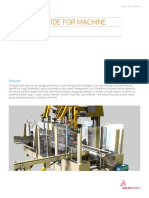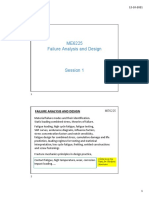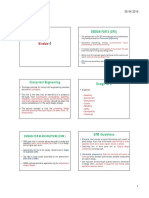0 ratings0% found this document useful (0 votes)
36 views19 pagesReliability in Design
Uploaded by
SuyashCopyright
© © All Rights Reserved
We take content rights seriously. If you suspect this is your content, claim it here.
Available Formats
Download as PDF or read online on Scribd
0 ratings0% found this document useful (0 votes)
36 views19 pagesReliability in Design
Uploaded by
SuyashCopyright
© © All Rights Reserved
We take content rights seriously. If you suspect this is your content, claim it here.
Available Formats
Download as PDF or read online on Scribd
You are on page 1/ 19
Reliability in Design
‘©The reliability of a product is strongly influenced by decisions made during the design
to correct as development proceeds.
‘= Itis often not practicable or economic to change a design once production has started.
‘+ It is therefore essential that design disciplines are used which minimize the possiblity
of failure and which allow design deficiencies to be detected and corrected as early as
possible.
The basic requirements for failure-free design were laid down, Le. adequate safety
‘margins, protection against extreme load events and protection against strength
degradation. The design must also take account of all other factors that ean affect
reliability, such as production methods, use and maintenance, and failures not caused
by load.
© The design process must therefore be organized to ensure that feilure-free design
principles are used and that any deviations from the principles are detected and
corrected
© Failure-free design is the only acceptable principle for any reliability conscious project
team. Anything less will be reflected in the acceptance of failures throughout the
development and production cycle, and a low rate of improvement.
‘© The designer must produce designs which will not fail if manufactured and used as
specified. In order to be able to do this test data may be needed to reduce uncertainties.
‘© Any subsequent failures can then be firmly classified as design deficiencies which
‘escaped the review or test system, or as being due to manufacturing failures or overload.
Failure-free design therefore involves prevention, check and cure.
COMPUTER-AIDED ENGINEERING
Computer-Aided Engineering methods are available to assist with a wide variety of
design tasks. Their power, ease of use, and increasing availability due to reducing costs of
‘computing equipment and software are resulting in increasing applications. CAE also makes,
possible the eration of designs which would otherwise be very difficult or uneconomic. for
example electronic circuits (CAE for electronic design is usually refered to as electronic
design automation (EDA).
CAE can also provide enormous improvements in engineering productivity. Properly
ns. eires
a a oct
simulation program can be used to design
used, it can lead tothe creation of more reliable des
&
Proprietary versions of the SPICE analog
electron circuits, and to test their operation under
performance details ar held in the database. The de
then build’ it and testi, all on the computer screen. The effects of parameter changes oF
modes ean be quickly evaluated, and dynamic as well as static operating conditions can be
tested. More advanced software exists for digital ci
different operating conditions. Component
signer can, in principle, design the cireult,
lure
it design and evaluation.
In the mechanical engineering field, software is available for stress analysis, which
performs finite element analysis calculations for mechanical and thermal stress calculations,
‘and for analysis of vibration and load responses. Drafting software is used for generating,
‘manufacturing drawings and machine tool instructions, and this can also be used to optimize
the design of mechanisms.
ble for design and analysis of systems and
Specialist CAE software is also avi
products incorporating other technologies, such as hydraulics, magnetics, and microwave
technology capability is now also being provided, so that mixed technology
electronics. Mult
designs can be modelled and analysed.
CAE provides the capability for rapid assessment of diferent design options, and for
‘analysing the effects of tolerances, variation, and failure modes. Therefore, if used in a
systematic, disciplined way, with adequate documentation of the options studied and
ity and reliability. CAE
assessments performed, designs can be optimized for costs, produc
should be considered as a powerful aid to more cost effective and correct design, not merely a
‘means of speeding up the design process.
However, there are important limitations inherent in most CAE tools, The software
models can never be totally accurate representations of all aspects of the design and of its
operating environment. For example, clectronie circuit simulation programs generally ignore
the effects of electromagnetic interference between components, and drafting systems will
ignore distortion due to stress or temperature. Therefore, itis essential that engineers using
CAE are aware of the limitations, and how these could affect their designs. The effective
application of modem CAE places greater responsibility upon designers to be aware of the
practical aspects and limitations of the relevant technologies. Otherwise they can be easily
‘misled into placing undue faith in the accuracy and completeness of the software models,
resulting in incorrect or unreliable designs.
ENVIRONMENTS,
The environments in which the product will be expected to be stored, operated and
‘maintained must be carefully assessed, as well as the expected severity and durations. The
assessment must include all aspects that could affect the product's operation, safety and
relia
ity. Physical factors include temperature, vibration shock, hut
ty, pressure, ete
Extreme values and, where relevant rates of change must be considered. Other environmental
Conditions, such as corrosive atmosphere, electrical interference, power supply variation, etc,
‘must also be considered. Where appropriate, combined environmental conditions, such as
temperature/ corrosive atmosphere and vibrati
1 contamination, should be assessed. An aspect
of environment often neglected in the treatment of the product by people, in storage, handling,
‘operation and maintenance.
En
yamental aspects should be reviewed systematically, and the review should be
properly documented.
‘The protective measures to be taken must be identified, as appropriate to storage,
transport, handling, operation and maintenance. Protective measures include packaging,
provision of waming labels and instructions, protective treatment of surfaces, and design
features
Resistance to environmental con
ms must be confirmed by test when hardware is
available.
LOAD PROTECTION
Protection against extreme loads is not always possible, but should be
considered whenever practicable. In many cases the maximum load can be pre-determined, and
no special protection is necessary. However, in many other loading situations extreme extemal
loads can occur and can be protected against. Standard products are available to provide
protection agains, for example, overpressure in hydraulie oF pneuma
systems, impact loads
fo electrical overload. When overload protection is provided, the reliability analysis is
performed on the basis of the maximum load which can be anticipated, bearing in mind the
tolerances of the protection system. In appropriate cases, loads which ean occur when the
protection system fails must also be considered.
However, in most practical cass it willbe sufficient to design to withstand
4 predetermined load and to acept the fet that loads above this wil use flue. The
letermined for a full elibiity analysis to be
mine the distribution of such extreme
fs of similar items, or from test or
probability of such loads occuring must be d
performed. It may not always be practicable to dete
events, but data may be available either from failure record
other records.
Where credible data are not available the worst design lod case must be
stated. The important point is thatthe worst design case is estimated and specified.
common cause of fulur isthe use af safety factors related to average conditions, without
adequate consideration having been given tothe extreme conditions which ean occur during
use ofthe product.
PROTECTION AGAINST STRENGTH DEGRADATION
Strength degradation, in its many forms, ean be one ofthe most difficult
aspects to take into account in design reliability analysis. Strength degradation due to fatigue
in metals fairly well understood and documented, and therefore reliability analysis involving
etl fatigue, including the effects of sires raisers such as notches, comers, holes and surface
Finish, can be performed satisfactorily, and parts canbe designed to operated below the fatigue
limit, or for defined safe lite
However, other weakening mechanisms are often more complex. Combined
stresses may accelerate damage of reduce the fatigue limit, Corrosion and wear are dependent
upon environments and lubrication, the effets of which are therefore often difficult to forecast.
[complete protection isnot posible, the designer must specify maintenance procedures for
inspection, lubrication or scheduled replacement.
Reliability analysis of designs with complex weakening processes is often
impracticable Tests should then be designed to provide the required data by generating failures
under known loading conditions.
DESIGN ANALYSIS METHODS
(Despite discipline, training and care, it is inevitable that occasional
‘oversights or erors will occur new designs. Design analysis methods have been developed to
highligh critical aspects and to focus attention on possible shortfalls)
metimes considered tedious and expensive. In most
Design analyses are
cases the analysis will show that nearly all aspects ofthe design are satisfactory, and much
more effort wil have been expended in showing this than in highlighting a few deficiencies.
However, the discovery of very few deficiencies at an appropriately early stage can save far
more than the costs that might be incurred by having to modify the design at a later stage, oF
by having to live with the consequences ofthe defect. Therefore, well-managed design analyses
are extremely cost-ffestive. The tedium and expense can be greatly reduced by good planning
an preparaon and by the ve of eomputerized metas nhs eto, we wil desrib the
anain design analysis techniques available. Their place inthe overall design review process and
the way they should be managed are also covered. The main reliability design analysis
techniques described are
1. Quality faction deployment.
2. Reliability prediction.
3. Load-strength analysis
4. Fllure modes, effets and eriicality analysis
3. Fault tee analysis.
6. Hazard and operability study.
7. Parts materials and process review.
8. Others, including human aspects manufacturing, maintenance, ee
Quality function deployment.
horrible expression fora simple
Quality Function Deployment (QFD)
technique to identify all of the factors which might affeet the ability ofa design or product 10
satisfy the customer, and the methods and responsibilities necessary to ensure control. QFD
g0¢s beyond reliability, as it covers aspects such as customer preferences for fel, appearance,
fe, but it is a useful and systematic way to highlight design and process activities and controls
necessary to ensure reliability.
are
‘QFD begins by a team consisting ofthe key marketing, design, production
reliability and quality staff working their way through the project plan or specification and
identifying the features that will require to be controlled. the control methods applicable, and
the responsible people. Constraints and risks are also identified, as well as resources necessary.
Attis stage no analysis or detailed planning is performed, but the methods likely to be applied
fed. These methods are described later in this chapter and in others.
QFD makes use of charts which enable the requirements to be listed, and
controls, responsibilities, constraints, et, to be tabulated, as they relate to design, analysis,
test, production ete, An example is shown in Figure.
Cortelahon
maine” K Xe
Features
Bl | 4
i ie
elge| § |e8ly
vawe IX] [2] a}a
wwgome WWM Pal s lola]
gimme felon foto] alel a
1 Few Ic) ] 0] 0] 2
Toaaing DX 4]e]@]@|@]a] = fa
4
q g_I8 [3/8 {8
i HEI BuM
el lee Sslegloal gel
slé SEE
‘This shows requirements ented on an importance (1-5), and the design
features that can affect them, Each feature i in tum rated against its contibuion © each
requirement, and a total rating ofeach feature is derived by multiplying each rating by the
importance value, and adding these values. Thus, the bearing selection hhousing construction,
‘and mounting design come out asthe most crtieal design features.
‘The conelation matrices indicate the extent 10 which requirements and
eatres interact: plus sign()indate positive comelaton and minus negative coreaton- For
example, magnet material and stator winding design might interct strongly. The minis signs
inthe requirements matrix indicate conflicting requirements.
‘The options available are shown, In some cases furher modeling
experiments are required, and tis prof the char can be used to Inccate the fables that
‘need t be included in such work,
“The shape ofthe QFD chart has led to its course being called the house of
qulity. OF quality here is sed in the widest sense to ineude all aspeets ofthe product that
“vill affect its eputation and cost. Figure is a topevel char: lower level chats are used 10
analyse more deed aspects, for example, more detsiled design and component
dancers, and production processes and tolerances, always against the same set of
requirements, Thus every aspect of design and production including analysis, est production
proces conto, final inspection, packaging, maintnanes et, is systematically evaluated and
planned for, alvays in eaton most important product requirements. Requirements and
features that are not important are shown up as such, and this ean be a very important
contribution to cost reduction and reliability improvement.
LOAD-STRENGTH ANALYSIS (LSA)
LLoad-sirength anelysis (LSA) is a procedure to ensure that all load and strength aspect have
been considered in deriving the design, and ifnecessary in planning of tests. The load-strengih
analysis (LSA) should include the follow
+ Determine the most likely worst-case values and patterns of variation of load and
strength
Evaluate the safety margin for intrinsic reliability
a i at
Determine protection methods (load limit, derating, screening, other quality control
‘wmethods)
Identify and analyse strength degradation modes.
Test to failure to corroborate, analyse results.
Corrector control (redesign, safe life, quality control, maintenance, etc).
Plastic ame Life testo condi
‘nweak lak Thickness of pode
fra at
tachment may be
‘ial ature
Overvolage
roecon or
proved
lng seeded
ee
Combine wih
=
&
Dawonpower 72C
supply variation
Operating ate
Das source
ayn
1s
Frequency?
probability of
ccurrnee|
Wrst case Ioad/
combines oad
Lav aarq
245 Cambent
Lead-stength analysis example
(043, uncton)
Perry
{aluminium Bi
bracket to
frame)
Sold el
Tale
tem
‘Above Table is an example of a hypothetical load-strength analysis for a mechanical and
electrical assembly. The example shows approaches that can be used for different aspects of
the analysis. Event probabilities can be expressed as full distributions, oras the likelihood of
particular limiting case being exceeded. The former is more appropriate when the load(s) an
cause degradation, or ifa more det
le reliability assessment is required. Both examples show
typical, though rather simple, cases where the effects of combined loads might have been
overlooked but for the analysis. For example, the solenoid might be supplied with
‘manufacture's rating of 28V operating, +2 V, and a maximum ambient temperature of 45 °C.
‘Atest room temperature of the solenoid might have confirmed its ability to function with a 32
\V supply without overheating. However, the combined environment of +45°C and 32 V supply,
albeit an infrequent occurrence, could lea to failure.
FAILURE MODES, EFFECTS AND CRITICALITY ANALYSIS (FMECA)
Failure modes effects and criticality analysis (FMECA) (or failure modes and effects
analysis (FMEA), is probably the most widely used and most effective design reliability
analysis method. The principle of FMECA is to consider each mode of failure of every
component of a system and to ascertain the effects on system operation of each failure mode
in tum, Failure effects may be considered at more than one level, eg. at subsystem and at
overall system level. Failure modes are classified in relation tothe severity of their effects.
‘An FMECA may be based ona hardware ora functional approach Inthe hardware
approach actual hardware failure modes are considered (e.g. resistor open circuit, bearing
~eiure). The factional approch is used when hardware tems cannot be uniquely identified
fr in early design stages when hardware is not fully defined. In this approach function
failures are considered (eg. no feedback, memory lost). Not that a functional failure mode
can become hardvae fleet havareapprosch FMECA. An FMECA can aso
be performed using «combination hada approsches
igure 1 and 2 show worksheets taken from US MIL-HBBK-1629. Method 101 is a
rnon-quanttative method, which serves to highlight failure modes whose effects would be
Considered important in relation to severity, detectability, maintainability o safety.
Method 102 maintainability or safety. (
ality analysis) includes consideration of
failure rate or probability, failure mode ratio and a quantitative assessment of criticality, in
order to provide a quantitative criticality rating for component or function. The failure mode
Where B= Condit
nal probability of loss of function or mission,
failure mode ratio,
2ypart failure or hazard rate,
‘operating or at-risk time of item
At can be replaced by failure probability, 1 —
‘The item criticality number is the sum of the failure mode eriticality numbers forthe item,
Steps in performit
‘An effective FMECA can be performed only by an engineer or team of engineers
1aving thorough knowledge of the system's design and application. The fist step therefore is
to obtain all the information available on the design. This includes specifications, drawings,
e js test results, ec, (0 the extent they are
‘computer-aided engineering (CAE) data, stress anal
available at the time, Fora criticality analysis the reliability prediction information must aso
be available or it might be generated simultaneously.
{A system functional block diagram and reliability block diagram should be prepared,
if not already avaiable, as these form the basis for preparing. the FMECA and for
understanding the completed analysis,
If the system operates in more than one phase in which different functional
red in the analysis, The
relationships or item operating modes exist, these must be co
effects of redundancy must also be considered by evaluating the effeets of failure modes
assuming that the redundant subsystem is or isnot available.
‘An FMECA can be performed from different viewpoints, such as success, safety,
lity, ete. It is necessary to
mission availability, repair cost, failure mode or effet detectal
decide, and to state, the viewpoint or viewpoints being considered in the analysis. For
example, a safety-related FMECA might give a low criticality number to an item whose
reliability seriously affects availabilty, but which is nt safety critica.
and the objectives ofthe analysis
are serious (high warranty costs, reliability reputation, safety ete.) the analysis should tke
account of all failure modes ofall components. However, it might be appropriate to consider
functional failure modes of sub-asemblies when these are based upon existing designs, eg.
‘modular power supplies in electronic systems, particularly if the design details are not
known.
FMECA should be started as soon as initial design information i available. It should
be performed iteratively as the design evolves, so thatthe analysis ean bgused to influence the
design and to provide documentation of the eventually completed design. Design options
should be separately analysed, so that reliability implications ean be considered in deciding
‘on which option to choose. Test results shouldbe use to update the analysis.
ES
FMECA is not a trivial task, and can involve many hours or weeks of work, It can
also be difficult to trace the effects of low-level failures correctly through complex system. If
the system has been designed or design modelled using CAE (or electronie automation:
EDA) software, this can be used to assist in the analysis, thus aiding the task of working out
the effects of component-level failures on the operation of complex systems. Even with aids
such as these, FMECA can be an inappropriate method for some designs, such as digital
electronic systems in which low-level failures (€., of transistors wit
integrated circuits)
ae very, but uniformly, unlikely, and the effects are dynamic in the sense that they could
Aifer widely depending upon the state of the system. FMECA is not appropriate for software
designs,
EMECA is widely used in many industries, particulary in those for which failures ean
have serious Consequences, such as military, aerospace, automotive, medical equipment, ete.
‘Some industries have established standardized approaches (the US Military Standard is MIL
Handbook-1629, and the US automotive companies have also produced a guidance
document, However, these present rather rigid approaches, which furthermore are not
appropriate for systems involving modem digital electronics, so they should be used only to
the extent required by contracts and as valid forthe technology.
Uses for FMECA
FMECAs can be used very effectively for several purposes, in addition t0 the
prime one of identifying safety or reliability critical feilure modes and effects. These include:
1. ening etres tobe included inthe test programe,
2. Preparation of diagnosis routines sich as owehas or faufinding tables. The
MICA provides convenient isting ofthe file modes which produce particular
fai tet or ymploms, and ths relive iketfoods of occurene,
~
Preparation of preventive mantnace requirments. Te effets and Heine
fils canbe considered in elation othe sed for scheduled inspection Serving ot
replacement. For example, ifa failure mode has an insignificant effect on safety or
‘operating suecess, the item could be replaced only on failure rather than at scheduled
intervals, to reduce the probability of failure
Design of built-in test (BIT), failure indications and redundancy. ‘The failure
etectability, including BIT, viewpoint is an important one in FMECA of system
‘which include these features
5. For analysis of testability, particularly for electronic subassemblies and systems, 10
‘ensure that hardware can be economically tested and failures diagnosed, using
automatic or manual test equipment.
66. For development of software for automatic test and BIT.
lity analysis, to be used as
7. For retention as formal records of the safety and reli
evidence if required in reports to customers or in product safety litigation.
8. An FMECA can be performed specifically to consider the possibility of produetion-
induced failures, e.g, wrong diode orientation, Such a production FMECA ean be very
useful in test planning and in design for ease of production.
It's important to coordinate these activities, so that the most effective use ean be made of the
EMECAs in all of them, and to ensure that FMECAs are available atthe right time and to the
right people.
Kontthecls-1)
|
Syn es Date
tndertre love Shoot or
| Roterence orawing Compiled by
Mission Approved by
temtuncional Mission phase! Faure
tenticaton | gonstcaion Fature modes [operational Satection | Compensating | Severity
umber | (eomenctature)| Function | andcauses |rmode mmotned | provisions | class | Remarks
Figure 7.2. MIL-STD-1629 worksheet for method 101
wisogg m Avge
ratio
me
Faiure|Faiture|
Figure 7.3 MIL-STD-1629 worksheet for method 102
stahyouy Rasy pee s20f3opoyy aumrog
Fresno
RELIABILITY PREDICTIONS FOR FMECA,
‘Since FMECAs are performed primarily to identify critical failure modes and to evaluate
ity values which could be considered as realistic worst
design options, failure rate or rei
‘cases should be used. Standard methods sometime stipulate the reliability prediction methods
10 be used, e.g. MIL-HDBK-217 for électronies. However, it is very important to appreciate
the large amount of uncertainty inherent in reliability prediction, particularly at the level of
individual failure events, Therefore, worst-case or pessimistic reliability values should always,
be used as input assumptions for failure modes which are identified as critical, or which
“Diabet a eras tana
might be eritical if the pessimistic assumption proved to be realistic. Alternative
and.
preferably unless eredible quantitative data are available, a value scale such as 0-1 should be
used, with prearranged assignment (e.g. 1 = will definitely occur, 0.5 = will occur
occasionally, 0.1 = will rarely occur, 0 = will never occur). Generally, the more critical the
failure mode the more pessimistic should be the worst-case reliability assumptions
A hazard is « peenbial Sauce
of Farum
HAZARD AND OPERABILITY STUDY (HAZOPS)
1e for the systematic determination of
Hazard and operability study (HAZOPS) is a tec
the potential hazards that could be generated by a system, and of the methods that should be
applied to remove or minimize them. It is used in the development of systems such as
Petrochemical plant, railway systems, etc. and usually is part of the mandatory safety
approval process. Table A shows an example of the format used.
For the failure/deviation column, a set of 'guidewords is sometimes applied to help in the
identification of things that could possibly go wrong. The usual guide words are:
-no/not
-less
as well as
-patt of
-reverse
-other than
Table 1 HAZOPS on motion system (partial)
Component/Failure/ Possible C
Function ‘Deviation Cause/s Event Wo Safeguards Action:
Electrical No power
ces fo powe L Main Power System failure (1) Provide standby System
Hydrauli Main AND ie ce ra
Hyde in 1. Main AND
ae dandy ha pressure SPStem failure 2) Checks on Maintenance
4 sooo Maintenance schedule
. Main AND ‘
ove, 5YStem failure (2) |
PWM circuit Permanent ‘on’ gave all
See FMEA
Solenoid valve Stu; on
*k Ope" Conrseon Sram fare) To be determined Analysis, tst
Stem failure (3) To be det
termined Test
HAZOPS should cover the whole range of potential failure causes, including natural
hazards,human failures, etc
ELTA aN
PARTS, MATERIALS AND PROCESSES (PMP) REVIEW
All new parts, materials and processes called up in the design should be identified. “Ne
this context means new to the particular design and production organization. The designer is
ikly to assume that part or meal wl perform as spect in the brochure and that
process canbe conlled to comply wi the design. The reliability and quality assurance
(ex) staf must ensure that his hs wel funded, New pats, material and processes must
therefore be assessed or teste before being applied, so that adequate ning for production
people an be planned quali contol sefeguards setup and ltemaivesouoes loated; New
parts, ‘and processes must be formally approved for production and added to the
approved lists,
‘Materials and processes must be assessed in relation to reliability. The main reliability
considerations include:
1. Cyelical loading. Whenever loading is cyclical, including frequent impact loads, fatigue
‘must be considered.
2, External environment, The environmental conditions of storage and operation must be
‘considered in relation to factors such as corrosion and extreme temperature effects.
3. Wear, The wear properties of materials must be considered for all moving parts in contact.
‘There is such a wide variation of material properties, even among categories such as steels,
aluminium alloys, plasties and rubbers, that it is not practicable to generalize about how these
should be considered in relation to reliability. Material selection will be based upon several
factors; the design review procedure should ensure that the reliability implications receive the
attention appropriate to the application.
NON-MATERIAL FAILURE MODES
“Most reliability engincering is concemed with material failure, such as caused by load-strength
interference and strength degradation. However, there isa large class of failure modes which
are not related to this type of material failure, but which can have consequences which are just
as serious. Examples of these are:
1. Fasteners which secure essential panels and which can be insecurely fastened due to
‘wear or left unfastened without being detected,
2. Wear in seals, causing low pressure leaks in hydraulic systems.
3._ Resistance increase of electrical contacts due to arcing and aceretion of oxides.
Lc
Failure of protective surfaces, such as paints, metal plating or anodized surfaces.
Distortion of pins, or intermittent contact, on multipin electrical connectors.
Drift in electronic component parameter values.
Electromagnetic interference (EMI) and timing problems in electronic systems.
Other personnel-induced failures such as faulty maintenance, handling or storage, e.g.
‘omitting to charge electrolytic capacitors kept in long-term storage, which can result in
reduced charge capacity in use.
9. Interface problems between sub-systems, due to tolerance mismatch.
All of these modes can lead to perceived failures. Failure reporting systems always include a
proportion of such failures. However, there is usually more scope for subjectiv
terpretation
and for variability due to factors such as skill levels, personal attitudes and maintenance
procedures, especially for complex equipment.
Non-material complex equipment. failures can be harder to assess atthe design stage, and often
do not show up during a test programme. Design reliability assessments should address these
types of failure, even though it may be impracticable to attempt to predict the frequency of
‘occurrence in some cases, particulary for personnclinduced failures.
HUMAN RELIABILITY
“The term ‘human reliability’ is used to cover the situations in which people, as operators or
‘maintainers, can affect the corrector safe operat
‘of systems. In these circumstances people
are fallible and can cause component or system failure in many ways.
Human reliability must be considered in any design in which human falibilty might affect
reliability or safety. Design analyses include such as FMECA and FTA should specific
consideration of human factors, such as the possiblity of incorrect operation oF maintenance,
ability to detect and respond to failure conditions, and ergonomic or other Factors that might
influence them.
‘Attempts have been made to quantify various human error probabilities, but such data should
be treated with caution, as human performance is too variable to be eredibly forecastable from
past records, Human error probabil
is usually very dependent on training, supervision, and
‘motivational factor, so these must be considered inthe analysis. Of course, in many cases the
design organization has litle or no control over these factors, but the analyses can be used to
highlight the need for specific training, independent checks, oF operator and maintainer
instructions and warnings.
You might also like
- Design For Reliability Analisa Kegagalan Teknik Mesin USUNo ratings yetDesign For Reliability Analisa Kegagalan Teknik Mesin USU25 pages
- Shigley's Mechanical Engineering Design 11th EditionNo ratings yetShigley's Mechanical Engineering Design 11th Edition21 pages
- General Engineering Principles and The Design ProcessNo ratings yetGeneral Engineering Principles and The Design Process22 pages
- Unit 12 Factors Affecting Product Design: Structure100% (1)Unit 12 Factors Affecting Product Design: Structure12 pages
- Modes of Failure of Mechanical Component:: Nptel PDFNo ratings yetModes of Failure of Mechanical Component:: Nptel PDF9 pages
- Session 7 & 8 Economics of Eng. Design INo ratings yetSession 7 & 8 Economics of Eng. Design I23 pages
- Durability 101 Don't Get Tired of FatigueNo ratings yetDurability 101 Don't Get Tired of Fatigue30 pages
- Reliability & Failure Analysis: BY: Abdullah Omar Mohammed Abou ReashaNo ratings yetReliability & Failure Analysis: BY: Abdullah Omar Mohammed Abou Reasha8 pages
- Through The Design Process: Guide On Achieving Reliability100% (1)Through The Design Process: Guide On Achieving Reliability19 pages
- Design For Reliability: Pranit Dhole (PA 09) Manish Jadhav (PA 14) Tejas Shinde (PA 06) Abhishek Birajdar (PA 23)No ratings yetDesign For Reliability: Pranit Dhole (PA 09) Manish Jadhav (PA 14) Tejas Shinde (PA 06) Abhishek Birajdar (PA 23)14 pages
- Design For Reliability Information and Computer Based Systems 1st Edition Eric Bauer Download100% (1)Design For Reliability Information and Computer Based Systems 1st Edition Eric Bauer Download56 pages
- Advances in Reliability and System Engineering 1st Edition Mangey Ram Instant DownloadNo ratings yetAdvances in Reliability and System Engineering 1st Edition Mangey Ram Instant Download147 pages
- GET 373 - LECTURE - 2 - Engineering - DesignNo ratings yetGET 373 - LECTURE - 2 - Engineering - Design17 pages
- EG 701 ME Mechanical Engineering Design: Instructor: SS Adig ANo ratings yetEG 701 ME Mechanical Engineering Design: Instructor: SS Adig A48 pages
- Mathcad Design Studies Trade-Off AnalysesNo ratings yetMathcad Design Studies Trade-Off Analyses7 pages
- Analysis Guide For Machine Designers EnglishNo ratings yetAnalysis Guide For Machine Designers English9 pages
- Solidworks WhitePaper Industry Sim Analysis Machines PDFNo ratings yetSolidworks WhitePaper Industry Sim Analysis Machines PDF9 pages
- Specifying Reliability: Definition of FailureNo ratings yetSpecifying Reliability: Definition of Failure3 pages
- On Developing Integrated Systems Architecture and Systems Engineering Courses at RitNo ratings yetOn Developing Integrated Systems Architecture and Systems Engineering Courses at Rit10 pages







